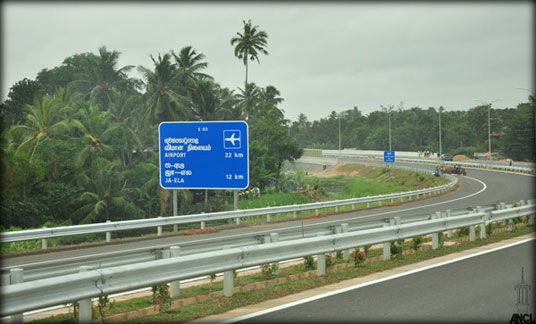A quick ride to the airport
 Airlines generally advise their passengers to be at the airport at
least three hours before the departure time of their flight. It can be a
little more flexible if you have checked in online (web check in) but
generally it is better to be at the airport well ahead of your departure
time. Airlines generally advise their passengers to be at the airport at
least three hours before the departure time of their flight. It can be a
little more flexible if you have checked in online (web check in) but
generally it is better to be at the airport well ahead of your departure
time.
In the case of the Bandaranaike International Airport at Katunayake,
this is compounded by the woeful traffic on the highly congested
Colombo-Negombo Road. It is never a good idea to delay your start when
you have to travel to the airport on this notoriously traffic-filled
road. I have sometimes spent well over two hours just to get to the
airport from Peliyagoda, even though I had (thankfully) given myself a
wide berth with regard to the departure time.
Very soon, there will be an alternative way to reach the airport -
the 28 Km Colombo-Katunayake Expressway (CKE), also known as E-03, built
in around four years with Chinese aid.
The Colombo-Galle Southern Expressway has given us a foretaste of
what we can expect. That expressway has shortened the journey time to
Galle from Kottawa to a mere one hour. It too will be extended to Matara
and then to Hambantota, shortening journey times further.
The US$ 350 million CKE is getting its final touches, in preparation
for the official opening on October 27. This is only the second
expressway constructed in Sri Lanka and will create a faster road link
between the Bandaranaike International Airport (BIA) in Katunayake and
Colombo. In fact, it will be possible to reach the BIA in just 20
minutes from Colombo (travelling at a speed of 100 Km/h), which is
impossible on the current road facility.
It will be of immense help to airline passengers and crews, apart
from those living at the five interchanges on the way. It will also
speed up air cargo, which is especially crucial for the transport of
perishable goods.
The CKE will be a great fillip for the tourism industry, which is
aiming to attract 2.5 million tourists in the short term. A quick link
to the city centre often impresses visitors and also gives them more
time to spend for other things.
Interchange
The Kerawalapitiya interchange of the CKE will connect to the Colombo
Outer Circular Expressway which in turn is connected to the Southern
Expressway. Once all the expressways are complete, there will be a
direct link through expressways from to BIA to Matara, with an extension
to the Hambantota Rajapaksa International Airport.
 It will then be possible to travel from one airport to the other in a
couple of hours. This will be part of a larger network of highways
connecting major cities throughout the country including Kandy,
Kurunegala, Kalpitiya, Jaffna and Batticaloa. Therefore, the CKE will be
a vital link in the extensive road system that is being constructed all
over the island. It will then be possible to travel from one airport to the other in a
couple of hours. This will be part of a larger network of highways
connecting major cities throughout the country including Kandy,
Kurunegala, Kalpitiya, Jaffna and Batticaloa. Therefore, the CKE will be
a vital link in the extensive road system that is being constructed all
over the island.
Expressways were not a familiar concept to Sri Lankans until 2011,
except for the comparatively few who had driven on expressways abroad.
Now that most Sri Lankans have experienced the Southern Expressway,
(which is turning two years on November 27) the CKE will not be an
all-new experience. Nevertheless, a sustained media campaign (especially
TV and radio) should be launched on the safety and other aspects of the
CKE, similar to the campaign undertaken for the Southern Expressway.
One alarming aspect in that regard is the regular occurrence of fatal
accidents on the Southern Expressway, which we hope will not permeate to
the CKE. It seems that some drivers still do not adhere to the rules
that are specifically tailored to the expressway, such as the speed
limit, overtaking method, the relevant lane etc.
Police deployed at both expressways must also increase vigilance -
i.e, check whether drivers and passengers are wearing seatbelts and
whether the vehicle is in a sound condition. Drivers too must complete
their own check-list with regard to safety aspects before embarking on
an expressway journey. Speeding to catch a flight makes no sense if it
results in injury or death.
The CKE has been a long-felt need. In fact, when attempts were made
decades ago to build an airport expressway, it was shot down on the
basis of high costs.
Had it been allowed to be built, the country could have saved
billions of rupees in terms of construction costs, land acquisition,
manpower and of course, fuel. Just imagine the thousands of litres of
fuel that go waste when motorists sit idle in their cars on the
Colombo-Negombo Road. For its modern incarnation, feasibility studies
were carried out as early as 1996. Despite several initiatives,
successive governments were unable or unwilling to initiate the project
until the present Government gave the go-ahead.
Luggage
We also hope that transport authorities will have a new bus service
to the airport on the expressway. The buses should have plenty of room
for luggage as well, at least until we build a city check-in service for
passengers. A direct city-airport public transport link is essential to
promote Colombo as a hub destination. A better, more reliable taxi
service is also required. It is also essential to build a direct rail
link to the airport.
The expressway will have only two toll gates. However, the
authorities should expedite the introduction of the proposed Electronic
Toll Collection (ETC) system at both expressways. That will help
smoothen the flow of traffic and end the long queues at toll gates.
A cash toll gate must also be maintained for those who might not have
subscribed to the ETC.
It is also heartening to note that the expressway has been
constructed with as little as possible impact on the environment. The
CKE will help flood control since it has established a proper culvert
system in the area.
A balance has to be struck between environmental and developmental
concerns and a compromise solution is sometimes necessary in the case of
mega developmental projects. After all, roads are the main arteries that
keep the economy flowing in the correct direction. |

